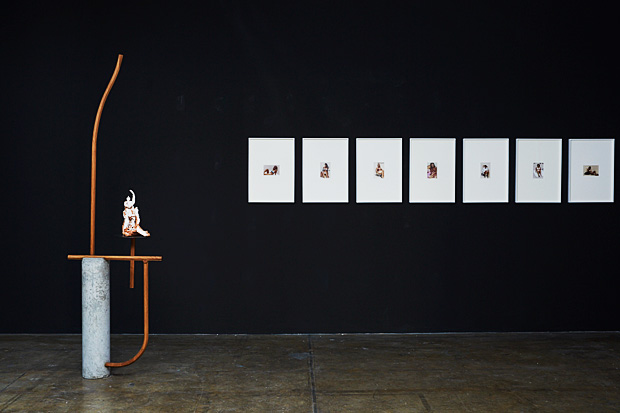What is in an artefact? Evidence of cultural or historical interest is restrained and appears unostentatious in Dusadee Huntrakul's solo exhibition "There Are More Monsoon Songs Elsewhere". Nevertheless, through the superposition of timelines and geographical locations, the imagined rituals, songs and dances of the everyday come to life at 100 Tonson Gallery.
Featuring hyperrealistic drawings of bracelets that were discovered at the Ban Chiang archaeological site, found photographs and installations, the exhibition invites viewers to explore the tensions between fine art, craft and design through the works' different techniques and materials, while questioning the status of the artefact, as it becomes a valuable -- often exoticised -- collectable over time.
Photograph-like, Dusadee's 16 charcoal drawings of bracelets on A4 paper appear as documentation taken from the archaeological site in Udon Thani, where the objects were found in 1966. In reality, the artefacts are now kept and exhibited at the Los Angeles County Museum of Art.
As an artist often working with clay and ceramics, Dusadee investigates the history and culture woven into the material itself.
"I started to study clay objects that were found in Japan, in the United States, the Czech Republic. Naturally, I found myself drawn to pottery from Ban Chiang," he says.
The act of exhibiting his drawings of bracelets and bangles stored in a foreign museum can be perceived as an attempt to repatriate those items. However, the images are simulacra that aren't merely copies of the objects, but become a truth in their own right.
The show's title, "There Are More Monsoon Songs Elsewhere", comes from the artist's pondering the myths and chanting rituals associated with the craftsmanship of a bygone era.
"Having grown up in an urban setting, I've never heard of songs about the monsoon in Thailand, about myths, people and spirits, in relation to the environment surrounding us," he says. As a result, Dusadee imagines the tropical setting in which these bracelets were created, and the connected ceremonial rites are still contained in the objects themselves.

His interest in animism and celebratory customs also makes its way into his ceramics, sculptures and installations, created in collaboration with designer Naroot Pitisongwat of Flo Furniture. The Night Dancer, House Of The Yamori King and Then I Will Put On My Makeup And Dance are all presented on airy pedestals made of wood, metal and concrete, as a nod to the evolution of techniques and technology since the prehistoric era of Ban Chiang, while playing with the traditional notion of the pedestal through the use of negative space. Meanwhile, Tales Of The Intestine Double Siamese Dreams -- To Be Continued is exhibited on a ready-made, plastic Muji shelf, opening a new dialogue on the topic of design -- contrasting local craftsmanship with global brands.
"Designing furniture is directly linked to daily life usages," Dusadee says about his collaboration with Naroot, which relates to the everyday quality of rituals and the artefacts that have become lost over time.
Ironically, it is not his series of bracelet drawings that is titled Artifacts, but a collection of found photographs the artist discovered in a cabinet drawer in a Los Angeles thrift store.
Dusadee looks at the photographs of beachwear-clad women, their bodies leisurely stretched out in public spaces, with an anthropological eye. While Ban Chiang artefacts are viewed as exotic when exhibited to Western audiences, the culture of sunbathing presented in the found photographs is equally foreign to traditional Thai lifestyles.
In the same way that one analyses prehistoric objects to find out about the lives of the community that created them, Dusadee invites viewers to contemplate the photographs searching for clues, studying the subjects' 1980s clothing and hairstyles and deducing aspects of their lifestyles.
"The bracelets indicate social status and other aspects of their wearer's life. Wearers tell themselves and tell others, 'This is my identity', similarly to our clothing," he adds.
Circulating through the exhibition, the audience picks up on connections between Dusadee's varied sets of works that are engaged in constant dialogues and tensions, from the hyperrealistic charcoal drawings to the photographs to a series of childlike, nervous drawings on animistic and post-human themes.
Realised with equally earthy materials, the graphite works feature stick-figures and doodle-like lines, as Dusadee moves through space, activating his whole body to draw on the large paper.
"What I like about paper and pencils is that they are materials accessible to all," he explains. "A pencil costs a maybe 10 baht, a notebook is maybe 15 baht, depending on the quality of the paper." Meanwhile, contemporary viewers also have a closer relationship to the works, having experienced the act of drawing lines on paper themselves.
"Pencil work is often regarded as a sketch rather than a finished artwork, and thus holds less value," Dusadee adds, just like craft is commonly considered at a lower level than fine art. It is up to the audience to flip this hierarchy.

